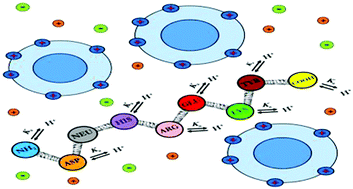Influence of macromolecular crowding on the charge regulation of intrinsically disordered proteins†
Abstract
In this work we study the coupling between ionization and conformational properties of two IDPs, histatin-5 and β-amyloid 42, in the presence of neutral and charged crowders. The latter is modeled to resemble bovine serum albumin (BSA). With this aim, semi-grand canonical Monte Carlo simulations are performed, so that the IDP charge is a dynamic property, undergoing protonation/deprotonation processes. Both ionization properties (global and specific amino acid charge and binding capacitance) and radius of gyration are analyzed in a large range of pH values and salt concentrations. Without crowder agents, the titration curve of histatin-5, a polycation, is salt-dependent while that of β-amyloid 42, a polyampholyte, is almost unaffected. The salt concentration is found to be particularly relevant at pH values where the protein binding capacitance (directly linked with charge fluctuation) is larger. Upon addition of neutral crowders, charge regulation is observed in histatin-5, while for β-amyloid 42 this effect is very small. The main mechanism for charge regulation is found to be the effective increase in the ionic strength due to the excluded volume. In the presence of charged crowders, a significant increase in the charge of both IDPs is observed in almost all the pH range. In this case, the IDP charge is altered not only by the increase in the effective ionic strength but also by its direct electrostatic interaction with the charged crowders.



 Please wait while we load your content...
Please wait while we load your content...